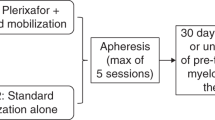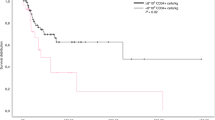Abstract
We investigated the outcomes of patients with breast cancer undergoing induction chemotherapy, mobilization of peripheral blood stem cells (PBSC) and high-dose chemotherapy (HDC) with PBSC infusion. One hundred and fourteen patients with untreated stage IV breast cancer, with a median age of 46 years (range 24–62), were entered on a phase II trial consisting of: (1) doxorubicin, 5-flurouracil, methotrexate (AFM) × 4 courses at 2 week intervals; (2) cyclophosphamide (4 g/m2), etoposide (600 mg/m2), cisplatin (105 mg/m2) (CEP), filgrastim (6 μ All patients received AFM, 107 (94 g/kg/day) and PBSC collection; (3) cyclophosphamide (6 g/m2), thiotepa (500 mg/m2), carboplatin (800 mg/m2) (CTCb) followed by PBSC infusion. %) received CEP, 93 (82%) received CTCb and PBSC as per protocol and 99 (87%) ultimately received HDC and PBSC. There was one infectious death after AFM and all other deaths were associated with progressive disease. Fifty-two patients (46%) are alive, 21 (18%) without progression, at a median 31 months (range 22–47). The probabilities of survival and progression-free survival at 3.5 years were 0.40 and 0.17, respectively. All 62 patients with visceral disease and/or a prior history of doxorubicin adjuvant therapy have relapsed or progressed. We conclude that the sequential administration of AFM, CEP and CTCb followed by PBSC resulted in long-term PFS only in patients who were NED, had bone-only disease or had lymph node or soft tissue disease with or without bone disease. Other strategies, aimed at improving responses to initial therapy, improving HDC regimens and/or developing immunomodulatory therapies, will be necessary to improve PFS for patients who fail doxorubicin adjuvant or who have visceral disease.
This is a preview of subscription content, access via your institution
Access options
Subscribe to this journal
Receive 12 print issues and online access
$259.00 per year
only $21.58 per issue
Buy this article
- Purchase on Springer Link
- Instant access to full article PDF
Prices may be subject to local taxes which are calculated during checkout
Similar content being viewed by others
Author information
Authors and Affiliations
Rights and permissions
About this article
Cite this article
Weaver, C., West, W., Schwartzberg, L. et al. Induction, mobilization of peripheral blood stem cells (PBSC), high-dose chemotherapy and PBSC infusion in patients with untreated stage IV breast cancer: outcomes by intent to treat analyses. Bone Marrow Transplant 19, 661–670 (1997). https://doi.org/10.1038/sj.bmt.1700728
Received:
Accepted:
Issue Date:
DOI: https://doi.org/10.1038/sj.bmt.1700728
Keywords
This article is cited by
-
Interleukin-2 and granulocyte–macrophage–colony-stimulating factor immunomodulation with high-dose chemotherapy and autologous hematopoietic stem cell transplantation for patients with metastatic breast cancer
International Journal of Hematology (2009)
-
High-dose thiotepa, melphalan and carboplatin (TMCb) followed by autologous stem cell transplantation in patients with advanced breast cancer: a retrospective evaluation
Bone Marrow Transplantation (2003)
-
High-dose chemotherapy and CD34-selected peripheral blood progenitor cell transplantation for patients with breast cancer metastatic to bone and/or bone marrow
Bone Marrow Transplantation (2001)
-
Mobilization of peripheral blood stem cells following myelosuppressive chemotherapy: a randomized comparison of filgrastim, sargramostim, or sequential sargramostim and filgrastim
Bone Marrow Transplantation (2001)
-
High-dose busulfan, melphalan and thiotepa as consolidation for non-inflammatory high-risk breast cancer
Bone Marrow Transplantation (2000)



